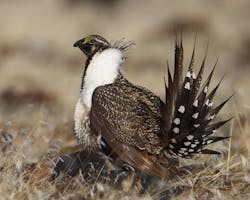Greater sage grouse populations in Wyoming declined 2.5%/year between 1984 and 2008 as oil and gas production grew there, a new study by the US Geological Survey and Colorado State University found. It used annual counts of male sage grouse at communal breeding sites known as leks in relation to wells’ density and areas of disturbance.
The analysis also included information about the distance of wells from leks, the potential for a delayed response of sage grouse populations following well development, characteristics of sagebrush habitat, and amounts of precipitation. The bird’s habitat covers parts of 11 western states and two Canadian provinces.
"This approach allowed us to look at long time periods, including years before the oil and gas boom, which gave us a better picture of how sage grouse have responded to oil and gas development,” said Dr. Adam Green, the lead author of the paper which was published in the Oct. 18 Journal of Wildlife Management and a former research scientist at Colorado State University.
“We found evidence of decreasing populations in response to increasing oil and gas development,” he said. “This response was apparent as far as 4 miles from a lek, and the response was strongest 4 years following development.”
"The 4-year delay in the response after well development may be an indication that energy development is impacting the production of male sage-grouse in the breeding population." said Steve Hanser, a USGS sagebrush ecosystem specialist.
“Male sage-grouse reach maturity after 2 to 3 years, so if development hinders recruitment there can be a delayed population response as adult males die and are not replaced by young males,” he explained.
Well density impacts
The study found that populations were stable when no wells were present near a lek, then began to decline when the first well was drilled. Declines were not statistically significant until well density reached about 10.4 wells/sq mile; however, at this well density, populations were predicted to decline 14%/year.
“Energy development continues to affect important sagebrush habitat required by sage-grouse and other species,” said Dr. Cameron Aldridge, an associate professor at CSU who cooperated with the USGS on the research.
“This analysis provides new information to managers on how sage grouse populations respond to energy development, as they simultaneously work to implement conservation measures for sage-grouse and meet demands for additional energy supplies,” he indicated.
The study’s results suggested that allowable well densities averaging one well pad per 640 acres, with up to 64 wells/pad, within Sage-grouse priority habitat management areas, called core areas in Wyoming, may only be sufficient for limiting population declines to current rates, but not for reversing the trend. The evaluation period was prior to management changes associated with the Wyoming core area policy and the paper does not assess the policy’s effectiveness.
US Interior Sec. Sally Jewell announced last year that the US Fish and Wildlife Service would not list the greater sage grouse as endangered or threatened under the federal Endangered Species Act following unprecedented cooperation involving state fish and game departments, oil and gas producers, county and local government, ranchers, sportsmen, environmentalists, and other stakeholders (OGJ Online, Sept. 22, 2015).
The Western Energy Alliance and North Dakota Petroleum Council jointly sued the US Bureau of Land Management and US Forest Service in May, charging that the agencies developed amended land use plans for the greater sage grouse that impose restrictions on new oil and gas leases and on development of existing leases (OGJ Online, May 13, 2016).
Contact Nick Snow at [email protected].



